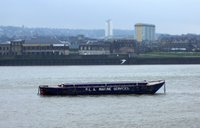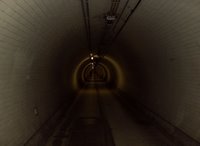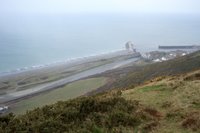Managed to get out early, just in time to catch the start of the rain… A brisk walk down to Barking and a short bus ride past the industrial and trading estates to Beckton, then through the Beckton Corridor to the beginning of Stage 15 of the Capital Ring. This walk links open spaces in Inner London.
Stage 15 leads through New Beckton Park and past the Royal Docks to the Thames at Woolwich, and ends at the northern entrance of the Woolwich Foot Tunnel. I know the area well from my work on the brilliant Port Cities website www.portcities.org.uk but there was already much new building since my last visit in 2004.

The splendid Gallions Hotel, built in the 1880s to accommodate long-distance travellers using the ocean liners in the Royal Albert Dock, is now being dwarfed by insipid new building. Surely enough, the new development did not advertise the fact that this is one of the windiest and bleakest spots in London.

The swing bridge over the entrance to the King George V Dock is the ideal place to appreciate the vastness of this body of water. The Port Cities site contains fascinating photographs taken from this spot, showing the docks full of ocean-going liners. The dock now lies empty. To the left lies the Tate & Lyle sugar refinery, the largest industrial plant left in the area, while straight ahead are the buildings of the Canary Wharf complex. To the right is the runway of the City Airport.

On to the Thames, and a new of the new developments on the site of the Woolwich Arsenal complex. A Port of London Authority Marine Services barge provides a reminder of the days when London was the biggest port in the world.

Stage 1 of the Capital Ring begins at the Woolwich Foot Tunnel, and gives another chance to use this fine example of Edwardian engineering. At one time, the tunnel would have been used by tens of thousands of workers at Woolwich Arsenal, the Royal Docks and the many industrial plants of Silvertown and North Woolwich, but few people use it today.

South of Woolwich, the Capital Ring changes in nature and becomes a trail linking London’s many parks and open spaces. These included formal parks such as the Maryon Wilson Park in Charlton, and playing grounds full of rugby teams in muddy shirts. At times, it was easy to forget that I was in the middle of a major metropolis. The first big surprise was Severndroog Castle, a triangular folly erected in 1784 to commemorate Sir William James of the East India Company. This fine building is now under threat – it seems incredible, but there was even a recent proposal to convert it into offices – and really deserves protection.

The rain got stronger as I limped towards Eltham, where I was delighted to find what appears to be a ruined ice-house. I got to Eltham Palace a few minutes before it was due to close. By this time the rain got too much and my feet had had too much, so I decided to call it a day. This was my longest single walk of the year, and included over 12 miles of the Capital Ring, which is a surprisingly attractive and varied trail.
Today: 16 miles
2006 total: 58 miles
 I continued the Capital Ring anti-clockwise from Eltham Palace, where I had stopped the other week. The walk led through a succession of pleasant, though largely featureless parks and green spaces, and this area was not built up until the interwar period.
I continued the Capital Ring anti-clockwise from Eltham Palace, where I had stopped the other week. The walk led through a succession of pleasant, though largely featureless parks and green spaces, and this area was not built up until the interwar period. Crystal Palace Park was the jewel of this part of the walk. The north end is particular fascinating, with the public architecture reminiscent of an English mini-Nuremberg. The whole complex now lies in sad decay.
Crystal Palace Park was the jewel of this part of the walk. The north end is particular fascinating, with the public architecture reminiscent of an English mini-Nuremberg. The whole complex now lies in sad decay.

















